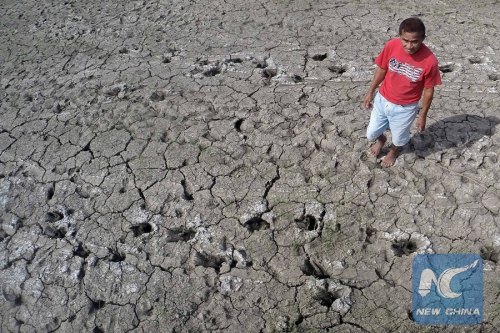
A farmer walks on the dried soil of a rice field in Tarlac Province, the Philippines, Feb. 3, 2016. The Philippine National Water Resources Board (NWRB) assured the water supply in Manila as the Philippine Atmospheric Geophysical and Astronomical Services Administration (PAGASA) kept its forecast that a strong El Nino is likely to continue until the second quarter of the year. (Photo: Xinhua/Rouelle Umali)
The powerful 2015-16 El Nino has passed its peak but remains strong and will continue to influence the global climate, according to the World Meteorological Organization (WMO) on Thursday.
Eastern and central tropical Pacific Ocean surface temperatures were more than 2 degrees Celsius above average in late 2015, providing evidence that the 2015-16 El Nino is one of the strongest on record, comparable with the 1997-98 and 1982-83 events.
However, WMO said the El Nino is expected to weaken in the coming months and fade away during the second quarter of 2016. As typically happens, the El Nino reached its peak ocean surface temperature during November and December, but has since declined by about half a degree.
"We have just witnessed one of the most powerful ever El Nino events which caused extreme weather in countries on all continents and helped fuel record global heat in 2015," said WMO Secretary General Petteri Taalas.
"In meteorological terms, this El Nino is now in decline. But we cannot lower our guard as it is still quite strong and in humanitarian and economic terms, its impacts will continue for many months to come," said Taalas.
The 2015-16 El Nino has been associated with a number of major impacts. For example, 2015 was the hottest on record by a wide margin because of the combination of the exceptionally strong El Nino and global warming caused by greenhouse gases.
WMO said that models indicate a return to an El Nino-Southern Oscillation neutral state during the second quarter of 2016.
El Nino is the result of the interaction between the ocean and atmosphere in the east-central Equatorial Pacific. It has an irregular recurrence period of between two and seven years. Typically, El Nino peaks late in the calendar year. It causes droughts and excess rainfall in different parts of the world.


















































